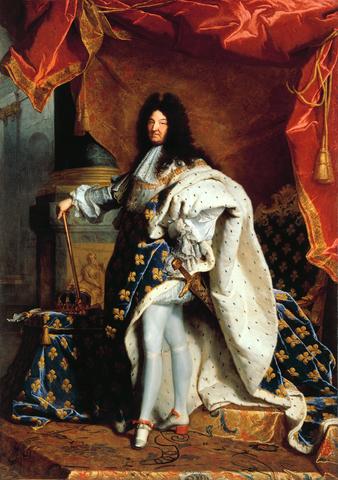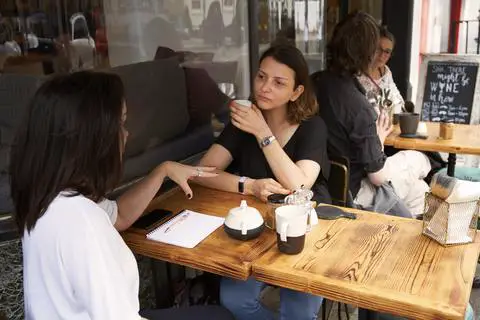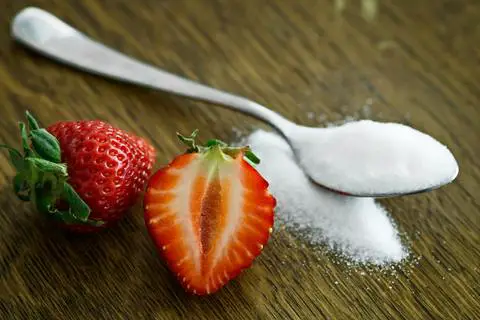The History of Coffee in France: Grand Origins
Coffee first made its way into France via Marseille, imported by Venetian merchants. However, it wasn’t until 1669 that coffee truly made headway in Paris for the first time. The Sultan of the Ottoman Empire, Muhammed IV, deployed his ambassador, Sulyeman Aga, to the court of King Louis XIV, the Sun King. Louis XIV had a reputation as both a curious and voracious gourmand and Suleyman Aga’s visit made quite the splash in Paris, particularly amongst the Parisian aristocracy.

Coffee, and coffee culture would continue to flourish and develop in France spreading to all different strata of society. Coffeehouses opened and attracted influential figures: actors, writers, poets, thinkers and political figures throughout French history.
Famous French Cafes To Visit
Le Procope/ Café Procope
Café Procope was opened in 1686 by the Sicilian Procopio Cuto. The restaurant and café is located on rue de l’Ancienne Comedie in the 6th arrondissement. It is often afforded the honor of being the oldest café in Paris, but actually closed in 1872 and reopened in the ‘20’s. That doesn’t change the incredible roster of figures that have enjoyed themselves at this café. During the 18th century Le Procope was one of the favored meeting places for scores of intellectuals and figures, especially before during and after the French Revolution. Some of the famous locals who spent time at le Procope included Rousseau, Voltaire, Diderot, Robespierre, Danton, Marat, George Sand, Anatole France, many contributors to the first Encyclopedie, the Encyclopedistes and even American Revolutionaries like Benjamin Franklin and Thomas Jefferson.
Les Deux Magots
Located at 6 Place, Saint-Germain des Pres in Paris, Les Deux Magots was once the rendezvous of choice for writers, playwrights, painters and other famous figures since it opened in 1873. The café is named after the two “magots” or “East Asian figurine statues” in the form of Chinese mandarins, perched on a column overlooking the interior of the café. Many of the giants of the Surrealist art movement in particular downed many cups of coffee here. Simone de Beauvoir, Jean-Paul Sartre, Ernest Hemingway, Albert Camus, Pablo Picasso, James Joyce and even Julia Child once were regulars at Les Deux Magots among other notable patrons.
Café de Flore
Les Deux Magots’ rival, located in close proximity on the same boulevard, is another one of the oldest and most famous cafes in Paris. Located at 172 Boulevard Saint-Germain, Café de Flore is also named after a statue, the Roman goddess of flowers and spring, Flora, who can be found on the opposite side of the boulevard from the café. Café de Flore has seen its fair share of incredible people enter its doors both from France and abroad. Jean-Paul Sartre and Simon Beauvoir also visited here along with Zhou Enlai, the first Premier of China, and Romanian thinkers like Emil Cioran and Eugene Ionesco.
La Rotonde
Located at 105, Boulevard Montparnasse, this café was a favorite of Ernest Hemingway. The Montparnasse area was a haven for bohemians from around the globe and it was this café in particular that Hemingway immortalized in his novel, the Sun Also Rises. Back when many artists whose names are known around the world were just starting out and just (some literally) starving artists, their work was showcased at this historic café. La Rotonde was even a muse for many works of art by the artists who frequented this café. Other former regulars included Pablo Picasso, Diego Rivera, Man Ray, Gertrude Stein, Samuel Beckett, Matisse, Degas and Marcel Duchamp.
And these are just a few of the many, many marvelous, famous, historic and vivacious cafes you will find all over, not just Paris, but other parts of France as well. But if you are to find yourself in one of these cafes, how and what should you order?
Un café, S’il vous plaît: Ordering Coffee in France
And now, café culture in France! As mentioned above coffee is a drink for a diverse array of people, from kings, like Louis XIV, to artists like Picasso, to revolutionaries like Danton and everyone in between.
In France, it is mostly uncommon to get coffee to go, with the exception of the airports, train stations or certain corner stores where busy travelers or working people may need to grab some joe and get a move on. In the case you need to get your coffee to go, look for places offering “café à emporter” which means, “coffee to go”.

Otherwise, indulge in taking your coffee “sur place”. The French prefer to take their time with their coffee and even sit and linger for a while after their drinks are finished, too- sometimes for up to a couple of hours taking in the sights and sounds of Paris. However, sitting outside is the prime real estate of the cafe and, often, the price will be higher than when sitting inside the café or at the bar- sometimes by up to 50%. Don’t worry about your server not bringing you the check promptly after you receive or finish your drinks; café culture in France is about enjoying your time!
France is similar to other parts of Europe- for example, Italy- where patrons are permitted to slow down and enjoy coffee at a more enjoyable pace. Its hard to imagine that the great philosophers, painters, poets, intellectuals and playwrights came up with their ingenious creations after chugging a coffee as fast as possible! The astounding ideas and art they created took time, hours of small talk with other like minded people, as well as arguing it out with people who didn’t think alike. Even just sitting alone with their thoughts for hours, taking in every last sip of caffeine, helped them masterfully produce creations that changed the world.
Le Menu: Options for French Coffee

Now for the fun part: what to order! While some items on a French coffee menu may be more or less analogous to cafes in other parts of the world, some items may be a bit different or go by other names altogether. There are also certain items that are only ordered at certain times of day or are most usually particular to certain meals. Though by all means, order whatever you’d like! Let’s take a look at some items and when and how to order them!
If you order un café, which is French for “a coffee”, you will receive a shot of espresso. Espresso may be offered as a digestif of sorts after lunch or dinner meals. Un double café is a double shot of espresso for those wanting an extra potent buzz. Some additional names for this noble little burst of caffeine include un petit café, un café noir, un petit noir, un café simple, and two cognates, un café express and un express. Un café is what you may want to opt for if you are in a hurry. Ordering one at the bar inside the café allows you to take a shot of espresso and be on your way. And for those who are particularly daring the café serré is the French equivalent of the ristretto and is a shot of finer ground espresso, using the same amount of grounds with half the water. This results in a more concentrated and thus more impactful shot! See our guide on the different types of espresso shots here for more information on the differences between normale, ristretto, and lungo shots!
To grab something similar to home, un café americain, also known as un café filtré is filtered or drip coffee and is a bit weaker compared to the espresso-based beverages. Café americain is served in a large cup, too. While French people usually opt for espresso based drinks, filtered and drip coffee is obtainable especially in areas that feature many tourist attractions.
Another coffee option similar to Americano is café allonge. This beverage is a shot of espresso served in a big cup that allows you to soften the strong blow of the espresso with water. This is actually the way that the Americano earned its name. According to the most commonly accepted story about the origins of the Americano, American soldiers stationed in Italy during World War II diluted their espresso with water. The reasons given usually that the soldiers were trying to emulate the coffee they were homesick for back in America, and possibly also because the bitter taste of the espresso wasn’t palatable to them. Whatever the truth behind the Americano may be, the café allonge is a good analogy for travelers wanting this classic café staple. Our guide on the Americano here more thoroughly covers some of the history of the Americano and its key traits.
Iced coffee is rare in France but a café glace is what you should keep your eyes peeled for.

Now, lets turn to the milk based coffee masterpieces in France. To acquire some milk with your coffee, order it along with your beverage, avec lait, s’il vous plait (with milk, please), or du lait, s’il vous plait (some milk, please). Otherwise, there is quite the roster of fantastic French coffee options with milk mixed right in. Café au lait is literally “coffee with milk”, and is drip coffee served in a large bowl with, you guessed it, milk. In French culture, this beverage is mainly only enjoyed for breakfast, usually at home and is one of the only times coffee will be enjoyed with food.
The noisette is another espresso based drink akin to a macchiato- espresso with one or two drops of cream or milk in a cup. The name, meaning “hazelnut”, refers not the flavor, but to the color of the espresso and the cream or milk mixing together. For those wanting a cappuccino, ordering cappuccino is possibly, but the French equivalent is café un crème. Both will yield espresso with hot milk or cream in a big cup. Some sources suggest only enjoying this option for breakfast as with café au lait, and not ordering cappuccino though your server will understand. Some of the warning against ordering it as cappuccino rather than café au crème is because it will result in you being charged the tourist price! (Like I was).
For those who prefer to sweeten up their java, sugar cubes or sticks are usually brought along with the coffee order. The sugar cubes are often brightly wrapped like lovely little packages. For those who have not had the pleasure of enjoying sugar cubes in their coffee this is an experience not to pass up. There is a way of enjoying sugar cubes with coffee in France called, “faire un canard” which means, “to make a duck”. This is because the sugar cube dips below the surface of the coffee and is eaten when it resurfaces. Like how a duck dives under water. And a useful phrase for those trying to get some more sugar for their coffee? “plus de sucre, s’il vous plaît” is a polite way of requesting some more of the sweet stuff.

Now, if the endless supply of espresso and sugar seems daunting, you can always opt for decaf. When you order your coffee add the word déca or décaféiné to the end of your coffee request. For example, “un café décaféiné s’il vous plait” will yield a decaf espresso.
Sources:
- 40-alexis-buisson. “French Coffee 101.” Frenchly, 24 Apr. 2019, frenchly.us/french-coffee-culture-101/.
- “Café Procope.” Wikipedia, Wikimedia Foundation, 3 June 2019, en.wikipedia.org/wiki/Caf%C3%A9_Procope.
- Isatoday. “A Definitive Guide to Coffee Culture in France.” ISA Today, 28 Feb. 2018, isatoday.wordpress.com/2018/02/28/a-definitive-guide-to-coffee-culture-in-france/.
- Kemp, Margaret, et al. “La Rotonde.” Bonjour Paris, 19 Jan. 2012, bonjourparis.com/paris-day-trips/la-rotonde/.
- Kemp, Margaret, et al. “The History of Coffee in Paris Since the Time of Louis XIV.” Bonjour Paris, 28 Apr. 2016, bonjourparis.com/food-and-drink/paris-brewing-history-coffee-since-time-louis-xiv/.
- “Les Deux Magots.” Wikipedia, Wikimedia Foundation, 14 Sept. 2019, en.wikipedia.org/wiki/Les_Deux_Magots.
- Luxeadventuretraveler. “5 Types of French Coffee, Explained.” Luxe Adventure Traveler, 30 Nov. 2018, luxeadventuretraveler.com/5-types-french-coffees-explained/.
- ThoughtCo. “How to Order Coffee in France.” ThoughtCo, ThoughtCo, 7 July 2019, www.thoughtco.com/ordering-coffee-in-france-1371160.
- TopBoss. “Top 5 Iconic Cafes You Must Visit in Paris.” Cover, 15 Aug. 2019, www.covermore.com.au/blog/europe/cafes-you-must-visit-in-paris.
